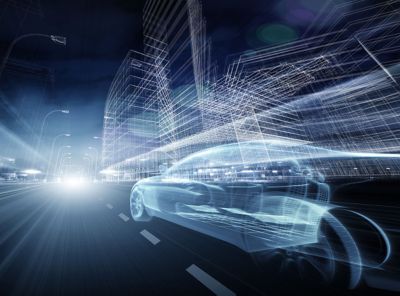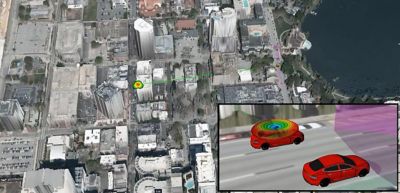-
United States -
United Kingdom -
India -
France -
Deutschland -
Italia -
日本 -
대한민국 -
中国 -
台灣
-
Ansys is committed to setting today's students up for success, by providing free simulation engineering software to students.
-
Ansys is committed to setting today's students up for success, by providing free simulation engineering software to students.
-
Ansys is committed to setting today's students up for success, by providing free simulation engineering software to students.
-
Contact Us -
Careers -
Students and Academic -
For United States and Canada
+1 844.462.6797
ANSYS BLOG
May 23, 2023
Build Smart Cities in a Digital Sandbox on the Road to Full Autonomy
Discover how digital mission engineering software could help set self-driving urban environments in motion
It’s no longer hard to imagine an automotive world driven entirely by electricity, connectivity, and artificial intelligence/machine learning (AI/ML). Autonomous vehicle (AV) tech could one day dramatically transform our view of the road ahead by simultaneously disincentivizing vehicle ownership, democratizing transportation, and freeing up more urban green space.
The future of self-driving vehicles is a particularly hot one among automotive original equipment manufacturers (OEMs), suppliers, and thought leaders. According to Forbes, total global investments in AV tech for 2022 exceeded $200 billion and are expected to continue their upward trajectory in what is becoming an increasingly competitive market.1
Consequently, within a few decades many of us could be ordering up AVs owned by transportation as a service (TaaS) companies to get around. Already, the idea is generating a lot of discussion behind the scenes among thought leaders trying to carry out what promises to be an incredibly complex mission: integrating technologies into automobiles and urban infrastructure that can support self-driving environments.
Just last year, in fact, at an automotive event organized by the Financial Times in London, Ansys Chief Technologist Christophe Bianchi met one of the developers involved in the futuristic city of Ali Mendjeli in Constantine, Algeria. Ali Mendjeli is one of several new cities being created as urban centers that adequately plan for and address the availability of housing for the local population.2
Central to their conversation was the much-anticipated move to higher levels of vehicle autonomy, and the role of AVs in redefining new urban infrastructure in ways that better accommodate people living within it. They discussed the need to extend autonomous technology to driving environments, and the ability of digital mission engineering to help deliver on that goal.
Digital mission engineering is defined as the use of digital modeling, physics-based simulation, and analysis to incorporate the operational environment and evaluate mission outcomes and effectiveness at every phase of the life cycle. Using digital engineering to create a model of the environment your system must perform in, you can simulate a model of your actual system operating within this environment or digital mission model and see how it fares — from development, through operation, maintenance, and sustainment.

Mapping the Digital Mission Within a Self-Driving Environment
To understand the role digital mission engineering might play in the implementation of autonomous tech on a broad scale, some context is needed. Some smart city visionaries expect AVs to be an important aspect of urban planning. They have even proposed limiting travel within smart cities to TaaS AV fleets exclusively. These shared fleets wouldn’t need large throughfares or as many parking lots, which will free up space for parks, open air markets, and other people-focused opportunities.
Despite recent advances in AV tech, implementing it on a broader scale is an incredibly complex task. Proper deployment will depend on multiple entities coming together to execute a much larger digital mission. It will also require a high level of synchronous, automated vehicle functionality through the seamless connection of disparate yet interconnected data systems, processes, and applications. For instance, downloading a vehicle software update as you're driving could enable the detection of an unseen vehicle coming around a corner while simultaneously rerouting based on construction.
Still, many other system interactions originate apart from an AV. Autotalks, for example, is a smart device designed to attach to a bike’s handlebars that can sense the presence of other vehicles and avoid a collision. It’s one of many systems communicating to other vehicles and related infrastructure within a broader ecosystem — activity supported by reliable connected service and coverage.
Ultimately, implementing the level of coordination needed to support activities like these depends on a long list of complex interactions, traceable over a single digital thread.
“Fully autonomous environments of the future will all be dictated by a larger communication grid coordinating vehicle movement,” says Bianchi. “The vehicle in the city talks to the city, talks to the other vehicles, and all of that involves a mission going from one place to another safely.”
Sifting Through Mission Complexity with Ansys Software
Ansys’ digital mission engineering capabilities, which have been applied to aerospace and defense (A&D) applications for years, are well-positioned to address the challenges of autonomous driving and smart cities.
“Everything being modeled for an autonomous driving environment involves a system or collection of systems designed from day one to carry out a mission of purpose,” says Nate McBee, senior manager, product management in the Digital Mission Engineering business unit at Ansys. “The mission comprises all the steps involved and all the pieces needed to validate and verify all the systems that make this level of autonomy possible.”
Whether you’re talking about traditional A&D applications or autonomous systems, the approach to digital mission engineering using tools like Ansys Systems Tool Kit (STK) is largely the same. It is, in the simplest of terms, a digital modeling approach in which you simulate the model of your system or systems in a model of the conditions it must operate under, to evaluate how well it will perform.
Achieving success in a fully autonomous driving environment will require support from key players like network infrastructure providers to build the high-speed networks that can accommodate real-time communication in dense urban centers. It will require the automotive industry as well as geographic information system solution providers for mapping well-timed digital routes according to established traffic patterns. As a matter of safety and compliance, close cooperation among national, state, and local regulatory bodies is also a must.

A commercial unmanned aerial system operation being modeled within an urban environment. Data like the expected signal quality shown at mission altitude from available cellular network stations would also be useful for autonomous vehicles in smart cities.
Connecting all the Dots in a Multidomain Operational Environment
In thinking about all of this activity, what resonates for McBee is the value of Ansys mission engineering software to connect all of the modeling and simulation activities in one multidomain operational environment model. This is true whether you’re considering autonomous systems in general, or the various pieces of infrastructure supporting those systems.
“Using a tool that’s specific to digital mission engineering and systems analysis, like STK, gives you a digital sandbox for bringing all of these models together,” says McBee. “Within that sandbox, you can analyze them all in the context of their interactions to find answers to questions that you previously weren’t able to ask. You can explore how a system or collection of systems supporting vehicle autonomy is going to perform under different conditions, situations, and scenarios within that operational environment.”
STK’s modeling environment is designed to be flexible so that you can ingest position or orientation data in an agnostic way. This enables you to derive benefits from other expert tools while leveraging all of the other aspects of the STK environment’s modeling and system of systems analysis approach.
One aspect to this modeling activity might involve bringing the resulting routes and positions and orientations supporting a fully autonomous vehicle fleet into STK, thus providing a place for the model to live if you want to simulate objects moving through space and time. This would also require accurate 3D models and all of the rest of the sensors systems and other things you want to represent on board that vehicle.
Within the context of this virtual model, certain questions might then be answered about vehicle performance. For example, what an actual AV would be able to see or detect around them in different driving conditions; or how well would they able to communicate with other actors and objects within different scenes. There’s also the question of how well the environment itself was modeled to reflect certain conditions and resolve various questions the user might have.
This type of activity informs a typical digital mission engineering approach. If you’re working within the framework of a mission model, it’s easy to swap out models or adjust operational conditions and rerun the mission again and again. This makes it possible to understand how one aspect of a system performs while holding all the other variables constant.

Ansys STK can incorporate radio frequency impacts while exploring vehicle link quality within urban environments.
Experience that Drives the Future
Ansys is well-positioned to support large scale AV system development. Over the years, the digital mission engineering team has built numerous workflows and tailored solutions to successfully solve A&D engineering challenges for satellite spacecraft, defense systems, and manned and unmanned aircraft.
This body of work is reflected in Ansys use cases, reference materials, and customer interactions over the course of several decades, representing a large repository of experience and expertise. All offer insight into the practical application of digital mission engineering that could be extended to a self-driving environment.
Of course, there’s still a lot of work to be done in the automotive space. If you’re curious about what the future holds for AV tech, and how Ansys digital mission engineering software is prepared to support it, check out Ansys’ Digital Mission Engineering solutions.
Resources
- Autonomous Vehicles And Their Impact On The Economy, Forbes.com, February 14, 2022.
- New town created according to the ascending procedure: Case of Ali Mendjeli, elibrary.net.
See What Ansys Can Do For You
See What Ansys Can Do For You
Contact us today
Thank you for reaching out!
We’re here to answer your questions and look forward to speaking with you. A member of our Ansys sales team will contact you shortly.











